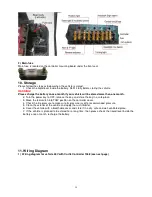
15
1. The battery is old and approaching the end of its life.
2. The battery was left in a state of discharge too long.
3. Electrolyte was lost due to spillage or overflow.
4. A weak or bad cell is developing.
5. Battery was watered excessively prior to testing.
Batteries in conditions 1 - 4 should be taken to a specialist for further evaluation or retired from service.
II. Open-Circuit Voltage Test
For accurate voltage readings, batteries must remain idle (no charging, no discharging) for at least 6 hrs,
preferably 24 hrs.
1. Disconnect all loads from the batteries.
2. Measure the voltage by a DC voltmeter.
3. Check the state of charge with Table 1.
4. Charge the battery if it registers 0% to 70% charged.
If the battery value is lower than that in Table 1, the following conditions may exist:
1. The Battery was left in a state of discharge too long.
2. The Battery has a bad cell.
Batteries in these conditions should be taken to a specialist for further evaluation or retired from service.
TABLE 1. State of charge as related to specific gravity and open circuit voltage
Percentage of
Charge
Specific Gravity
Corrected to
80
o
F
Open-Circuit Voltage
6V
8V
12V
24V
36V
48V
100
1.277
6.37
8.49
12.73
25.46
38.20
50.93
90
1.258
6.31
8.41
12.62
25.24
37.85
50.47
80
1.238
6.25
8.33
12.50
25.00
37.49
49.99
70
1.217
6.19
8.25
12.37
24.74
37.12
49.49
60
1.195
6.12
8.16
12.24
24.48
36.72
48.96
50
1.172
6.05
8.07
12.10
24.20
36.31
48.41
40
1.148
5.98
7.97
11.96
23.92
35.87
47.83
30
1.124
5.91
7.88
11.81
23.63
35.44
47.26
20
1.098
5.83
7.77
11.66
23.32
34.97
46.63
10
1.073
5.75
7.67
11.51
23.02
34.52
46.03
8) BATTERY INSTALLATION
WARNING!
When working with the battery, DO NOT put wrenches or any other metal objects across the battery
terminals, otherwise, an arc can occur, and it may cause explosion of the battery and physical injury.
Battery is to be installed or replaced only by a qualified electrician.
Содержание Street Legal
Страница 6: ...6 2 Controls 1 Schematic Figure of controls Fig 1 Fig 2 Fig 3 ...
Страница 27: ...27 ...














































